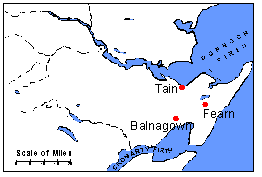
Clan Ross has the Gaelic language to thank for its name. In Gaelic Ross means "peninsula" or "promontory". This name was given to the area between the Cromarty Firth in the south and the Dornoch Firth in the North. In earlier Celtic times this area was part of the province of Moray. Later, this area was separated from it and elevated to an independent county.
In the case of Clan Ross this started around the Earl's of Ross from the O' Beolain family. Fearchar Mac an t-Sagairt (Son of the Priest) was the first of them. He got the title because of his support to King Alexander II when an uprising commenced in the area of Moray and Ross.
After the death of the 5th Earl in the O' Beolain line, the earlship comes in the hands of his daughter Euphemia. His brother, Hugh, then becomes the fist Chief of Clan Ross. Hugh, also called "of Rariches" because of the estate he got from his father, on this occasion also assumes the name Ross. From his brother William he also received the Balnagown estate after which this branch of the family will be called.
Until 1711 the Balnagown branch leads Clan Ross. In that year, David Ross, Baron Balnagown, the 13th chief, dies.
Between 1711 and 1893 the title and the Balnagown estate are in the hands of chiefs who weren't linked with the original O' Beolain family.
In the beginning of the 18th century the higher authorities (the English) find the clan system to undermine their authority. As a result of this the "Disarming-acts" were issued in 1716. The Highlanders had to hand in their arms. After the 1745 upraise the clansystem was forbidden, including the wearing of the highland dress, the traditional dress.
In the in the course of the 19th century, with the rise of Romanticism, the interest for the history of Scotland regenerates. The Clansystem however isn't going to be what it was.
After the death of Charles Henry August Frederick Lockhart-Ross, the last member of the Lockhart branch, the chiefship turns to the Pitcalnie branch. With this also a descendant of the O' Beolain family regains the post of Chief. With the dead in 1968 of Miss Rosa Ross Williamson Ross of Pitcalnie this branch also ends.
From that moment on the chiefship continues with the Shandwick branch. This branch springs from Hugh Ross of Balnagown, the 4th chief of Clan Ross. David Campbell Ross, born 11 February 1934, then becomes the 29th Chief of Clan Ross.
In spite of all changes the interest in Clan Ross continues to exist. Especially in the English speaking countries Clan Associations were formed. They seek to promote and foster the Clan spirit, offer help with genealogical research and give an opportunity to meet each other and exchange experiences.